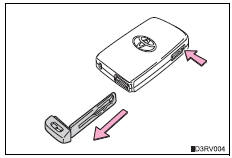Toyota RAV4 (XA40) 2013-2018 Owners Manual: Using the mechanical key (vehicles with a smart key system)
To take out the mechanical key, push the release button and take the key out.
The mechanical key can only be inserted in one direction, as the key only has grooves on one side.
If the key cannot be inserted in a lock cylinder, turn it over and reattempt to insert it.
After using the mechanical key,
store it in the electronic key. Carry
the mechanical key together with
the electronic key. If the electronic
key battery is depleted or the entry
function does not operate properly,
you will need the mechanical key.
If you lose your keys
New genuine keys can be made by your toyota dealer using a master key (vehicles without a smart key system) or the other key (vehicles with a smart key system) and the key number stamped on your key number plate. Keep the plate in a safe place such as your wallet, not in the vehicle.
When riding in an aircraft
When bringing a key with wireless remote control function onto an aircraft, make sure you do not press any buttons on the key while inside the aircraft cabin. If you are carrying the key in your bag etc., Ensure that the buttons are not likely to be pressed accidentally. Pressing a button may cause the key to emit radio waves that could interfere with the operation of the aircraft.
Notice
To prevent key damage
- Do not drop the keys, subject them to strong shocks or bend them.
- Do not expose the keys to high temperatures for long periods of time.
- Do not get the keys wet or wash them in an ultrasonic washer etc.
- Do not attach metallic or magnetic materials to the keys or place the keys close to such materials.
- Do not disassemble the keys.
- Do not attach a sticker or anything else to the surface of the electronic key.
- Do not place the keys near objects that produce magnetic fields, such as tvs, audio systems and induction cookers, or medical electrical equipment, such as low-frequency therapy equipment.
Carrying the electronic key on your person (vehicles with a smart key system)
Carry the electronic key 3.9 In. (10 Cm) or more away from electric appliances that are turned on. Radio waves emitted from electric appliances within 3.9 In. (10 Cm) of the electronic key may interfere with the key, causing the key to not function properly.
In case of a smart key system malfunction or other key-related problems (vehicles with a smart key system)
Take your vehicle with all the electronic keys provided with your vehicle to your toyota dealer.
When an electronic key is lost (vehicles with a smart key system)
If the electronic key remains lost, the risk of vehicle theft increases significantly.
Visit your toyota dealer immediately with all remaining electronic keys that was provided with your vehicle.
 The keys
The keys
The following keys are provided with the vehicle.
Vehicles without a smart key system (type a)
Master keys
Operating the wireless remote control
function
Valet key
Key number plate ...
Other materials:
Front passenger side rear airbag sensor circuit malfunction
Description
The rear airbag sensor rh consists of parts including the diagnostic circuit
and the lateral deceleration
sensor.
When the center airbag sensor receives signals from the lateral deceleration
sensor, it determines
whether or not the srs should be activated.
Dtc b1635/24 i ...
Air conditioning control panel does not operate
Description
This circuit consists of the air conditioning control and the air
conditioning amplifier. When the air
conditioning control is operated, signals are transmitted to the air
conditioning amplifier through the lin
communication system.
If the lin communication system malfunctions, ...
Outside rear view mirrors
The rear view mirror's position
can be adjusted to
enable sufficient confirmation
of the rear view.
â– When using the outside rear
view mirrors in a cold weather
When it is cold and the outside rear
view mirrors are frozen, it may not
be possible to fold/extend them or
adjust the mirror surface. Rem ...

